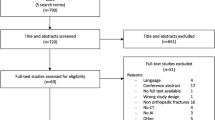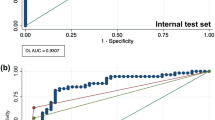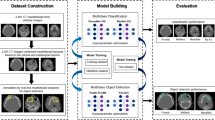Abstract
Objectives
This study aimed to evaluate the accuracy and reliability of convolutional neural networks (CNNs) for the detection and classification of mandibular fracture on spiral computed tomography (CT).
Materials and methods
Between January 2013 and July 2020, 686 patients with mandibular fractures who underwent CT scan were classified and annotated by three experienced maxillofacial surgeons serving as the ground truth. An algorithm including two convolutional neural networks (U-Net and ResNet) was trained, validated, and tested using 222, 56, and 408 CT scans, respectively. The diagnostic performance of the algorithm was compared with the ground truth and evaluated by DICE, accuracy, sensitivity, specificity, and area under the ROC curve (AUC).
Results
One thousand five hundred six mandibular fractures in nine subregions of 686 patients were diagnosed. The DICE of mandible segmentation using U-Net was 0.943. The accuracies of nine subregions were all above 90%, with a mean AUC of 0.956.
Conclusions
CNNs showed comparable reliability and accuracy in detecting and classifying mandibular fractures on CT.
Clinical relevance
The algorithm for automatic detection and classification of mandibular fractures will help improve diagnostic efficiency and provide expertise to areas with lower medical levels.




Similar content being viewed by others
References
Chrcanovic BR, Abreu MH, Freire-Maia B, Souza LN (2012) 1,454 mandibular fractures: a 3-year study in a hospital in Belo Horizonte, Brazil. Journal of cranio-maxillo-facial surgery : official publication of the European Association for Cranio-Maxillo-Facial Surgery 40:116–123. https://doi.org/10.1016/j.jcms.2011.03.012
Boffano P, Kommers SC, Roccia F, Forouzanfar T (2015) Mandibular trauma treatment: a comparison of two protocols. Medicina oral, patologia oral y cirugia bucal 20:e218–e223. https://doi.org/10.4317/medoral.20263
Boffano P, Roccia F, Zavattero E, Dediol E, Uglešić V, Kovačič Ž, Vesnaver A, Konstantinović VS, Petrović M, Stephens J, Kanzaria A, Bhatti N, Holmes S, Pechalova PF, Bakardjiev AG, Malanchuk VA, Kopchak AV, Galteland P, Mjøen E, Skjelbred P, Koudougou C, Mouallem G, Corre P, Løes S, Lekven N, Laverick S, Gordon P, Tamme T, Akermann S, Karagozoglu KH, Kommers SC, Forouzanfar T (2015) European Maxillofacial Trauma (EURMAT) project: a multicentre and prospective study. Journal of cranio-maxillo-facial surgery : official publication of the European Association for Cranio-Maxillo-Facial Surgery 43:62–70. https://doi.org/10.1016/j.jcms.2014.10.011
He D, Zhang Y, Ellis E 3rd (2007) Panfacial fractures: analysis of 33 cases treated late. Journal of oral and maxillofacial surgery : official journal of the American Association of Oral and Maxillofacial Surgeons 65:2459–2465. https://doi.org/10.1016/j.joms.2007.06.625
Shen D, Wu G, Suk HI (2017) Deep Learning in Medical Image Analysis. Annu Rev Biomed Eng 19:221–248. https://doi.org/10.1146/annurev-bioeng-071516-044442
Kalmet PHS, Sanduleanu S, Primakov S, Wu G, Jochems A, Refaee T, Ibrahim A, Hulst LV, Lambin P, Poeze M (2020) Deep learning in fracture detection: a narrative review. Acta Orthop 91:215–220. https://doi.org/10.1080/17453674.2019.1711323
Litjens G, Kooi T, Bejnordi BE, Setio AAA, Ciompi F, Ghafoorian M, van der Laak J, van Ginneken B, Sánchez CI (2017) A survey on deep learning in medical image analysis. Med Image Anal 42:60–88. https://doi.org/10.1016/j.media.2017.07.005
Olczak J, Fahlberg N, Maki A, Razavian AS, Jilert A, Stark A, Sköldenberg O, Gordon M (2017) Artificial intelligence for analyzing orthopedic trauma radiographs. Acta Orthop 88:581–586. https://doi.org/10.1080/17453674.2017.1344459
Chung SW, Han SS, Lee JW, Oh KS, Kim NR, Yoon JP, Kim JY, Moon SH, Kwon J, Lee HJ, Noh YM, Kim Y (2018) Automated detection and classification of the proximal humerus fracture by using deep learning algorithm. Acta Orthop 89:468–473. https://doi.org/10.1080/17453674.2018.1453714
Tomita N, Cheung YY, Hassanpour S (2018) Deep neural networks for automatic detection of osteoporotic vertebral fractures on CT scans. Comput Biol Med 98:8–15. https://doi.org/10.1016/j.compbiomed.2018.05.011
Adams M, Chen W, Holcdorf D, McCusker MW, Howe PD, Gaillard F (2019) Computer vs human: Deep learning versus perceptual training for the detection of neck of femur fractures. J Med Imaging Radiat Oncol 63:27–32. https://doi.org/10.1111/1754-9485.12828
Urakawa T, Tanaka Y, Goto S, Matsuzawa H, Watanabe K, Endo N (2019) Detecting intertrochanteric hip fractures with orthopedist-level accuracy using a deep convolutional neural network. Skeletal Radiol 48:239–244. https://doi.org/10.1007/s00256-018-3016-3
Lindsey R, Daluiski A, Chopra S, Lachapelle A, Mozer M, Sicular S, Hanel D, Gardner M, Gupta A, Hotchkiss R, Potter H (2018) Deep neural network improves fracture detection by clinicians. Proc Natl Acad Sci USA 115:11591–11596. https://doi.org/10.1073/pnas.1806905115
Zhou QQ, Wang J, Tang W, Hu ZC, Xia ZY, Li XS, Zhang R, Yin X, Zhang B, Zhang H (2020) Automatic Detection and Classification of Rib Fractures on Thoracic CT Using Convolutional Neural Network: Accuracy and Feasibility. Korean J Radiol 21:869–879. https://doi.org/10.3348/kjr.2019.0651
Kelly DE and Harrigan WF (1975) A survey of facial fractures: Bellevue Hospital, 1948–1974. Journal of oral surgery (American Dental Association : 1965) 33:146–9.
Cornelius CP, Audigé L, Kunz C, Rudderman R, Buitrago-Téllez CH, Frodel J, Prein J (2014) The Comprehensive AOCMF Classification System: Mandible Fractures- Level 2 Tutorial. Craniomaxillofac Trauma Reconstr 7:S015-30. https://doi.org/10.1055/s-0034-1389557
Yun Z, Yang S, Huang E, Zhao L, Yang W, Feng Q (2019) Automatic reconstruction method for high-contrast panoramic image from dental cone-beam CT data. Comput Methods Programs Biomed 175:205–214. https://doi.org/10.1016/j.cmpb.2019.04.024
Ronneberger O, Fischer P, Brox TJICoMIC and Intervention C-A (2015) U-Net: Convolutional Networks for Biomedical Image Segmentation.
Liu L, Cheng J, Quan Q, Wu F-X, Wang Y-P, Wang J (2020) A survey on U-shaped networks in medical image segmentations. Neurocomputing 409:244–258. https://doi.org/10.1016/j.neucom.2020.05.070
Taghanaki SA, Zheng Y, Kevin Zhou S, Georgescu B, Sharma P, Xu D, Comaniciu D, Hamarneh G (2019) Combo loss: handling input and output imbalance in multi-organ segmentation. Computerized medical imaging and graphics : the official journal of the Computerized Medical Imaging Society 75:24–33. https://doi.org/10.1016/j.compmedimag.2019.04.005
Loshchilov I and Hutter F (2017) Decoupled Weight Decay Regularization.
Dice LR (1945) Measures of the Amount of Ecologic Association Between Species 26:297–302. https://doi.org/10.2307/1932409
He K, Zhang X, Ren S and Sun JJI (2016) Deep Residual Learning for Image Recognition.
Russakovsky O, Deng J, Su H, Krause J, Satheesh S, Ma S, Huang Z, Karpathy A, Khosla A, Bernstein M, Berg AC, Fei-Fei L (2015) ImageNet Large Scale Visual Recognition Challenge. Int J Comput Vision 115:211–252. https://doi.org/10.1007/s11263-015-0816-y
Szegedy C, Vanhoucke V, Ioffe S, Shlens J and Wojna Z (2016) Rethinking the Inception Architecture for Computer Vision.
Ellis E 3rd, Moos KF, el-Attar A, (1985) Ten years of mandibular fractures: an analysis of 2,137 cases. Oral Surg Oral Med Oral Pathol 59:120–129. https://doi.org/10.1016/0030-4220(85)90002-7
Gassner R, Tuli T, Hächl O, Rudisch A, Ulmer H (2003) Cranio-maxillofacial trauma: a 10 year review of 9,543 cases with 21,067 injuries. Journal of cranio-maxillo-facial surgery : official publication of the European Association for Cranio-Maxillo-Facial Surgery 31:51–61. https://doi.org/10.1016/s1010-5182(02)00168-3
Erol B, Tanrikulu R, Görgün B (2004) Maxillofacial fractures. Analysis of demographic distribution and treatment in 2901 patients (25-year experience). Journal of cranio-maxillo-facial surgery : official publication of the European Association for Cranio-Maxillo-Facial Surgery 32:308–313. https://doi.org/10.1016/j.jcms.2004.04.006
Pinto A, Acampora C, Pinto F, Kourdioukova E, Romano L, Verstraete K (2011) Learning from diagnostic errors: a good way to improve education in radiology. Eur J Radiol 78:372–376. https://doi.org/10.1016/j.ejrad.2010.12.028
Krupinski EA, Berbaum KS, Caldwell RT, Schartz KM, Kim J (2010) Long radiology workdays reduce detection and accommodation accuracy. J Am Coll Radiol 7:698–704. https://doi.org/10.1016/j.jacr.2010.03.004
Brady AP (2017) Error and discrepancy in radiology: inevitable or avoidable? Insights Imaging 8:171–182. https://doi.org/10.1007/s13244-016-0534-1
Lee CS, Nagy PG, Weaver SJ, Newman-Toker DE (2013) Cognitive and system factors contributing to diagnostic errors in radiology. AJR Am J Roentgenol 201:611–617. https://doi.org/10.2214/AJR.12.10375
Erickson BJ, Korfiatis P, Akkus Z, Kline TL (2017) Machine learning for medical imaging. radiographics : a review publication of the Radiological Society of North America. Inc 37:505–515. https://doi.org/10.1148/rg.2017160130
Chartrand G, Cheng PM, Vorontsov E, Drozdzal M, Turcotte S, Pal CJ, Kadoury S and Tang A (2017) Deep learning: a primer for radiologists. Radiographics : a review publication of the Radiological Society of North America, Inc 37:2113–2131. doi: https://doi.org/10.1148/rg.2017170077
Deniz CM, Xiang S, Hallyburton RS, Welbeck A, Babb JS, Honig S, Cho K, Chang G (2018) Segmentation of the proximal femur from MR images using deep convolutional neural networks. Sci Rep 8:16485. https://doi.org/10.1038/s41598-018-34817-6
Qiu B, Guo J, Kraeima J, Glas HH, Borra RJH, Witjes MJH, van Ooijen PMA (2019) Automatic segmentation of the mandible from computed tomography scans for 3D virtual surgical planning using the convolutional neural network. Phys Med Biol 64:175020. https://doi.org/10.1088/1361-6560/ab2c95
Noguchi S, Nishio M, Yakami M, Nakagomi K, Togashi K (2020) Bone segmentation on whole-body CT using convolutional neural network with novel data augmentation techniques. Comput Biol Med 121:103767. https://doi.org/10.1016/j.compbiomed.2020.103767
Pranata YD, Wang KC, Wang JC, Idram I, Lai JY, Liu JW, Hsieh IH (2019) Deep learning and SURF for automated classification and detection of calcaneus fractures in CT images. Comput Methods Programs Biomed 171:27–37. https://doi.org/10.1016/j.cmpb.2019.02.006
Olczak J, Emilson F, Razavian A, Antonsson T, Stark A, Gordon M (2021) Ankle fracture classification using deep learning: automating detailed AO Foundation/Orthopedic Trauma Association (AO/OTA) 2018 malleolar fracture identification reaches a high degree of correct classification. Acta Orthop 92:102–108. https://doi.org/10.1080/17453674.2020.1837420
Cornelius CP, Audigé L, Kunz C, Rudderman R, Buitrago-Téllez CH, Frodel J, Prein J (2014) The comprehensive AOCMF classification system: mandible fractures-level 3 Tutorial. Craniomaxillofac Trauma Reconstr 7:S031-43. https://doi.org/10.1055/s-0034-1389558
Acknowledgements
The authors acknowledge the assistance of the radiological department of Peking University School and Hospital of Stomatology in Beijing, China, for database establishment.
The first author Dr. Xuebing Wang acknowledges the care and assistance from Dr. Ruiliu Li, Dr. Lihang Shen, Dr. Hang Wang, Dr. Chengyi Wang, Dr. Huiyu Peng, Dr. Xiyue Wang, and Feier Wang.
Funding
This study was supported by the National Key Research and Development Program of China (2019YFF0302401). The funding agencies had no role in study design, implementation procedures, analysis of results, or preparation of the manuscript.
Author information
Authors and Affiliations
Contributions
Yang He conceived the ideas. Xuebing Wang participated in the study design and collected and annotated all the data. Zineng Xu developed the algorithm. Xuebing Wang and Zineng Xu contributed equally to the article writing. Yanhang Tong and Long Xia participated in data annotation. Bimeng Jie contributed to the polish of the article. Hailong Bai and Peng Ding provided technical support. Yi Zhang provided the research platform. All authors commented on previous versions of the manuscript. All authors read and approved the final manuscript.
Corresponding author
Ethics declarations
Ethics approval
All the procedure was approved by the Ethics Committee of Peking University School and Hospital of Stomatology (protocol No. PKUSSIRB-202054056) and was conducted in accordance with the relevant guidelines and regulations.
Informed consent
For this type of study, formal consent is not required.
Conflict of interest
The authors declare no competing interests.
Additional information
Publisher’s note
Springer Nature remains neutral with regard to jurisdictional claims in published maps and institutional affiliations.
Rights and permissions
About this article
Cite this article
Wang, X., Xu, Z., Tong, Y. et al. Detection and classification of mandibular fracture on CT scan using deep convolutional neural network. Clin Oral Invest 26, 4593–4601 (2022). https://doi.org/10.1007/s00784-022-04427-8
Received:
Accepted:
Published:
Issue Date:
DOI: https://doi.org/10.1007/s00784-022-04427-8




